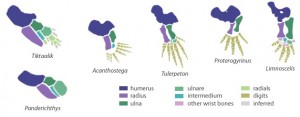What comes to mind when you think of dinosaur interaction? Large carnivores chomping on unsuspecting little ornithopods? Ceratopsians jousting for their next mate? Large hadrosaurs tenderly mothering their cute newborns? There are many possible images of community-level dinosaur interactions, and there is a host of evidence out there that take dinosaurs beyond the bones and breathe new life into how they lived.
How did birds get their wings?
How many fingers do you have? Hopefully, 5. Do you think that’s the normal condition for all animals? Do you think that’s air you’re breathing right now? … OK, so I watched the Matrix last night, but still, do you think all tetrapods (dudes with 4 feet, including you, and anything else with four flippers, wings, or feet) have 5 digits on each limb? Actually, there’s a pattern within tetrapods of limb reduction in various lineages – our earliest ancestors seemed to experiment with digit numbers and went a bit berserk by growing extra fingers from their fishy flippers.
Progressive Palaeontology, Leeds 2013
Progressive Palaeontology (ProgPal) is an annual event where early career researchers get to demonstrate their research to an equivalent audience in a reasonably informal atmosphere. It’s also renowned as a mega p*ss-up, as everyone knows palaeontologists are chronic alcoholics (hence the dinosaurs with feathers hypothesis). This year, it was in the vibrant and cosmopolitan northern UK city of Leeds. Some of the research communicated there was pretty freaking sweet. You can find recordings of all of the talks on Palaeocast (at some point in the future), and the Twitter feed was #progpal if you want to see a historical live version of the event.
The early evolution of dinosaurs
Dinosaurs. What springs to mind when they’re mentioned? Colossal, towering sauropods? Packs of feisty feathered fiends? Or huge herds of hadrosaurs, chomping their way across the plains of long-lost worlds? Most, including myself, will automatically default to any one of these images when dinosaurs come up in conversation (what, you mean it’s not that frequent for normal people?) But we often neglect to think the earliest dinosaurs, spectacular organisms that gave birth to the most successful, and on-going, terrestrial vertebrate radiation of all time.


